Leadership Styles and Adapting Management Systems to Millennials
VerifiedAdded on 2023/06/18
|7
|1573
|368
Report
AI Summary
This report provides an overview of various leadership styles, including transactional, transformational, servant, democratic, and autocratic leadership, and analyzes how organizations adapt their management systems to effectively manage the millennial generation. It discusses the characteristics of millennials in the workplace, such as their preference for updated technology, work-life balance, and freedom in decision-making. The report also highlights the challenges millennials face in organizations with outdated systems or autocratic leadership styles. The conclusion emphasizes the importance of organizations adopting suitable leadership styles and providing employees with the necessary skills and knowledge.
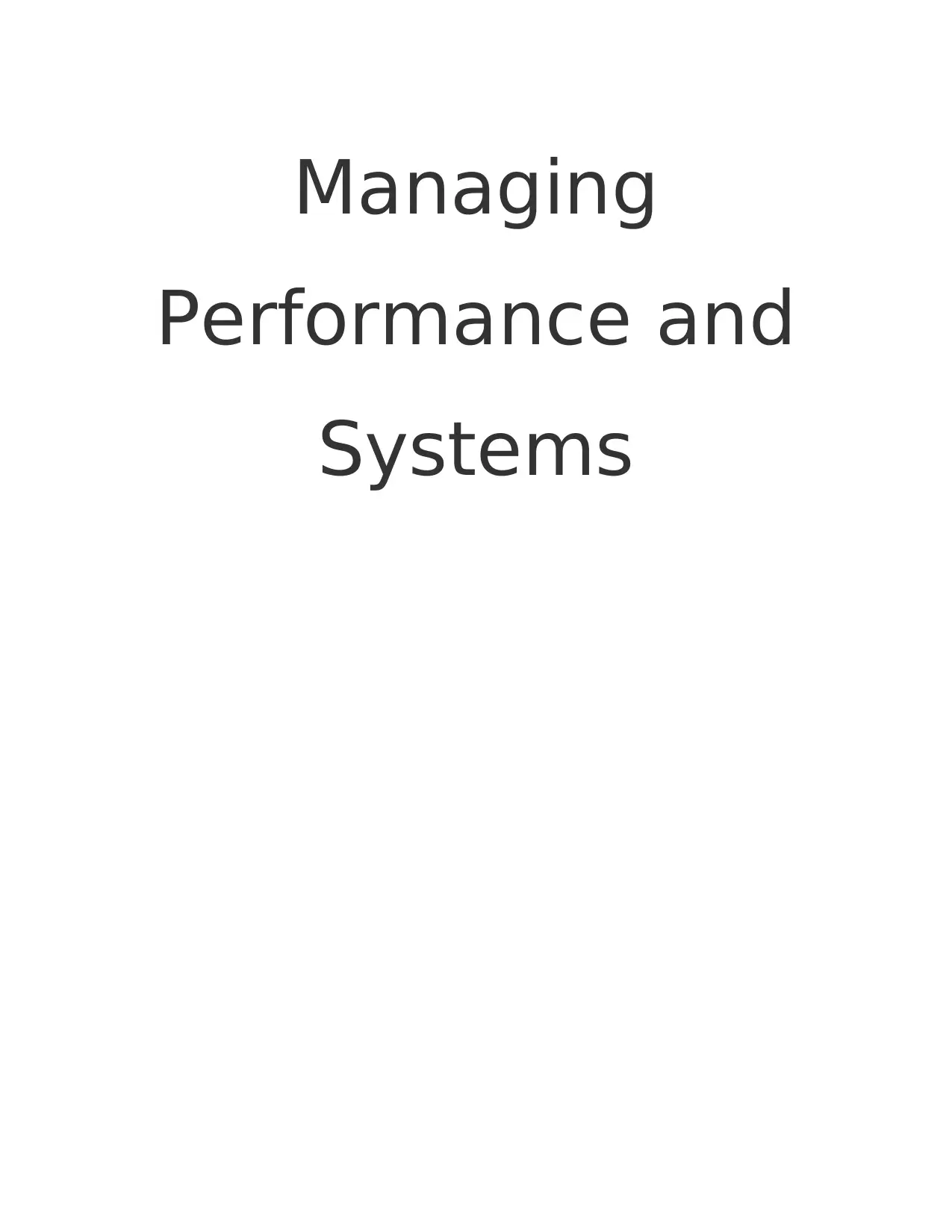
Managing
Performance and
Systems
Performance and
Systems
Paraphrase This Document
Need a fresh take? Get an instant paraphrase of this document with our AI Paraphraser
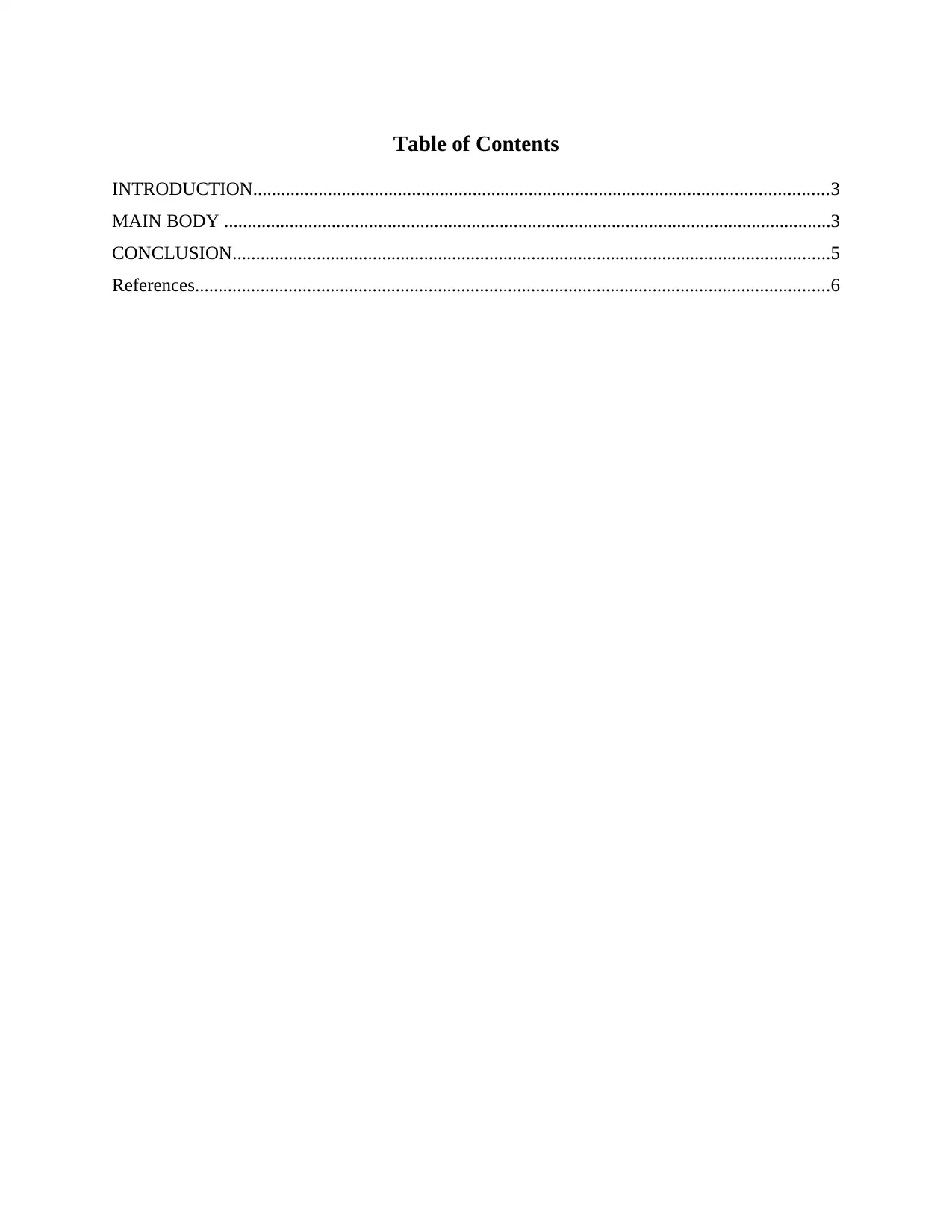
Table of Contents
INTRODUCTION...........................................................................................................................3
MAIN BODY ..................................................................................................................................3
CONCLUSION................................................................................................................................5
References........................................................................................................................................6
INTRODUCTION...........................................................................................................................3
MAIN BODY ..................................................................................................................................3
CONCLUSION................................................................................................................................5
References........................................................................................................................................6
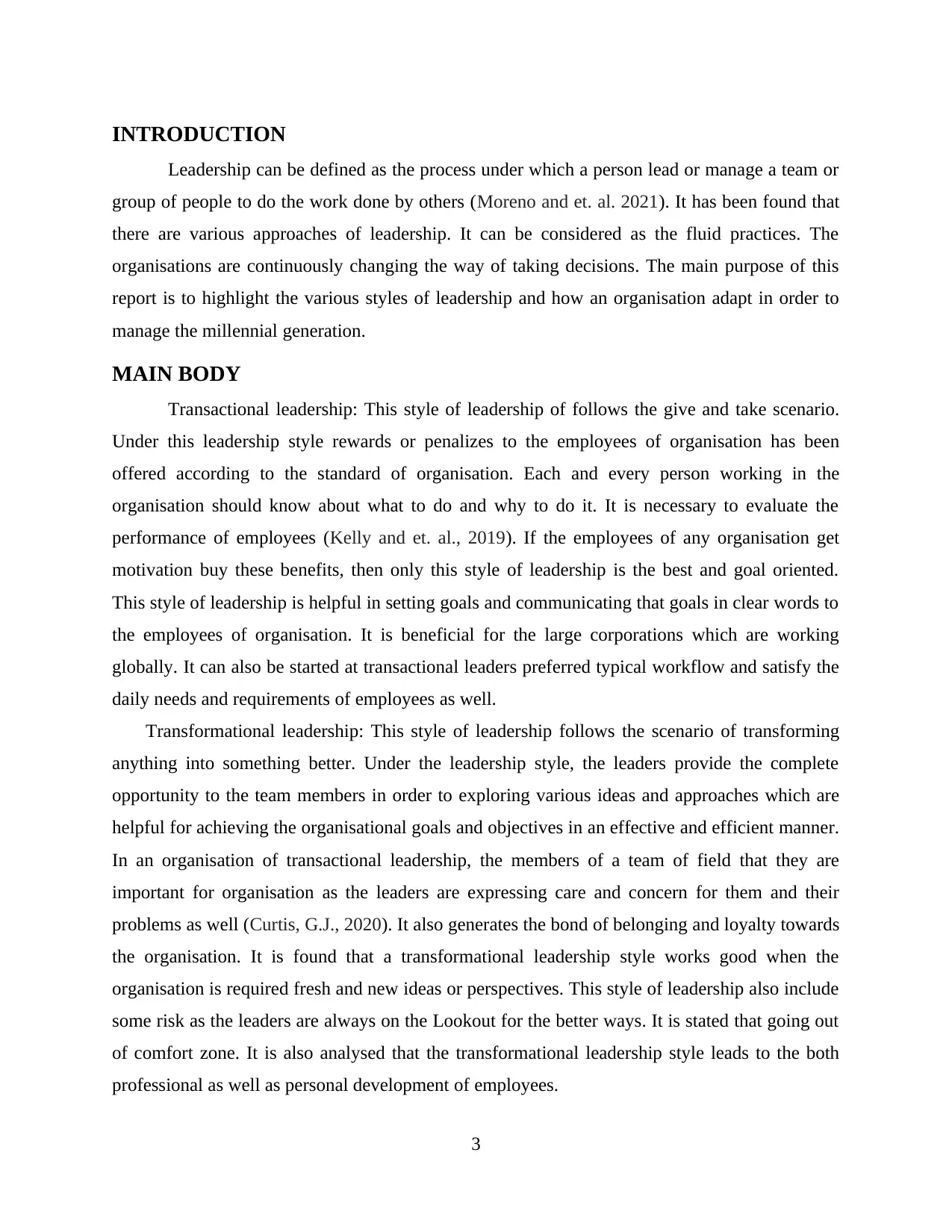
INTRODUCTION
Leadership can be defined as the process under which a person lead or manage a team or
group of people to do the work done by others (Moreno and et. al. 2021). It has been found that
there are various approaches of leadership. It can be considered as the fluid practices. The
organisations are continuously changing the way of taking decisions. The main purpose of this
report is to highlight the various styles of leadership and how an organisation adapt in order to
manage the millennial generation.
MAIN BODY
Transactional leadership: This style of leadership of follows the give and take scenario.
Under this leadership style rewards or penalizes to the employees of organisation has been
offered according to the standard of organisation. Each and every person working in the
organisation should know about what to do and why to do it. It is necessary to evaluate the
performance of employees (Kelly and et. al., 2019). If the employees of any organisation get
motivation buy these benefits, then only this style of leadership is the best and goal oriented.
This style of leadership is helpful in setting goals and communicating that goals in clear words to
the employees of organisation. It is beneficial for the large corporations which are working
globally. It can also be started at transactional leaders preferred typical workflow and satisfy the
daily needs and requirements of employees as well.
Transformational leadership: This style of leadership follows the scenario of transforming
anything into something better. Under the leadership style, the leaders provide the complete
opportunity to the team members in order to exploring various ideas and approaches which are
helpful for achieving the organisational goals and objectives in an effective and efficient manner.
In an organisation of transactional leadership, the members of a team of field that they are
important for organisation as the leaders are expressing care and concern for them and their
problems as well (Curtis, G.J., 2020). It also generates the bond of belonging and loyalty towards
the organisation. It is found that a transformational leadership style works good when the
organisation is required fresh and new ideas or perspectives. This style of leadership also include
some risk as the leaders are always on the Lookout for the better ways. It is stated that going out
of comfort zone. It is also analysed that the transformational leadership style leads to the both
professional as well as personal development of employees.
3
Leadership can be defined as the process under which a person lead or manage a team or
group of people to do the work done by others (Moreno and et. al. 2021). It has been found that
there are various approaches of leadership. It can be considered as the fluid practices. The
organisations are continuously changing the way of taking decisions. The main purpose of this
report is to highlight the various styles of leadership and how an organisation adapt in order to
manage the millennial generation.
MAIN BODY
Transactional leadership: This style of leadership of follows the give and take scenario.
Under this leadership style rewards or penalizes to the employees of organisation has been
offered according to the standard of organisation. Each and every person working in the
organisation should know about what to do and why to do it. It is necessary to evaluate the
performance of employees (Kelly and et. al., 2019). If the employees of any organisation get
motivation buy these benefits, then only this style of leadership is the best and goal oriented.
This style of leadership is helpful in setting goals and communicating that goals in clear words to
the employees of organisation. It is beneficial for the large corporations which are working
globally. It can also be started at transactional leaders preferred typical workflow and satisfy the
daily needs and requirements of employees as well.
Transformational leadership: This style of leadership follows the scenario of transforming
anything into something better. Under the leadership style, the leaders provide the complete
opportunity to the team members in order to exploring various ideas and approaches which are
helpful for achieving the organisational goals and objectives in an effective and efficient manner.
In an organisation of transactional leadership, the members of a team of field that they are
important for organisation as the leaders are expressing care and concern for them and their
problems as well (Curtis, G.J., 2020). It also generates the bond of belonging and loyalty towards
the organisation. It is found that a transformational leadership style works good when the
organisation is required fresh and new ideas or perspectives. This style of leadership also include
some risk as the leaders are always on the Lookout for the better ways. It is stated that going out
of comfort zone. It is also analysed that the transformational leadership style leads to the both
professional as well as personal development of employees.
3
⊘ This is a preview!⊘
Do you want full access?
Subscribe today to unlock all pages.

Trusted by 1+ million students worldwide
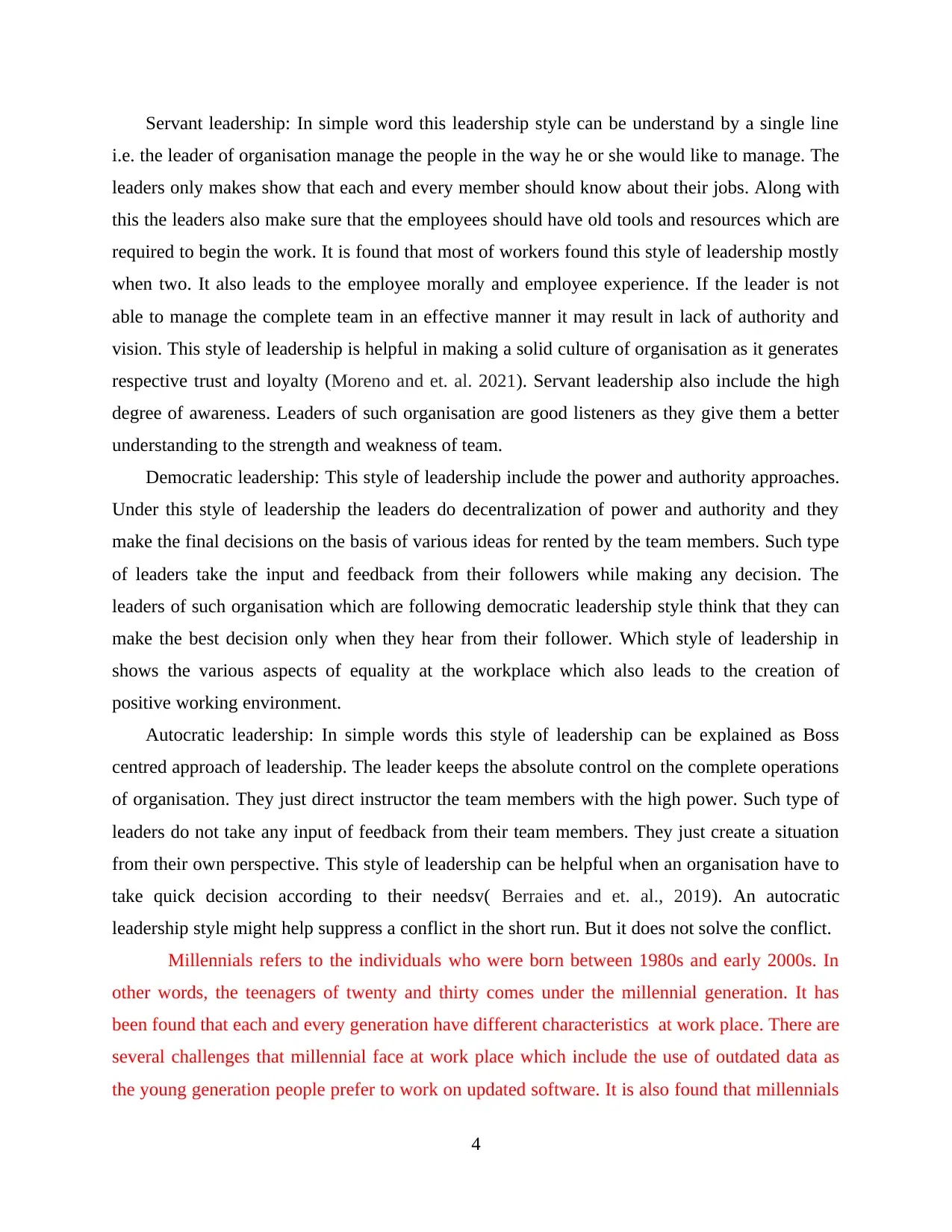
Servant leadership: In simple word this leadership style can be understand by a single line
i.e. the leader of organisation manage the people in the way he or she would like to manage. The
leaders only makes show that each and every member should know about their jobs. Along with
this the leaders also make sure that the employees should have old tools and resources which are
required to begin the work. It is found that most of workers found this style of leadership mostly
when two. It also leads to the employee morally and employee experience. If the leader is not
able to manage the complete team in an effective manner it may result in lack of authority and
vision. This style of leadership is helpful in making a solid culture of organisation as it generates
respective trust and loyalty (Moreno and et. al. 2021). Servant leadership also include the high
degree of awareness. Leaders of such organisation are good listeners as they give them a better
understanding to the strength and weakness of team.
Democratic leadership: This style of leadership include the power and authority approaches.
Under this style of leadership the leaders do decentralization of power and authority and they
make the final decisions on the basis of various ideas for rented by the team members. Such type
of leaders take the input and feedback from their followers while making any decision. The
leaders of such organisation which are following democratic leadership style think that they can
make the best decision only when they hear from their follower. Which style of leadership in
shows the various aspects of equality at the workplace which also leads to the creation of
positive working environment.
Autocratic leadership: In simple words this style of leadership can be explained as Boss
centred approach of leadership. The leader keeps the absolute control on the complete operations
of organisation. They just direct instructor the team members with the high power. Such type of
leaders do not take any input of feedback from their team members. They just create a situation
from their own perspective. This style of leadership can be helpful when an organisation have to
take quick decision according to their needsv( Berraies and et. al., 2019). An autocratic
leadership style might help suppress a conflict in the short run. But it does not solve the conflict.
Millennials refers to the individuals who were born between 1980s and early 2000s. In
other words, the teenagers of twenty and thirty comes under the millennial generation. It has
been found that each and every generation have different characteristics at work place. There are
several challenges that millennial face at work place which include the use of outdated data as
the young generation people prefer to work on updated software. It is also found that millennials
4
i.e. the leader of organisation manage the people in the way he or she would like to manage. The
leaders only makes show that each and every member should know about their jobs. Along with
this the leaders also make sure that the employees should have old tools and resources which are
required to begin the work. It is found that most of workers found this style of leadership mostly
when two. It also leads to the employee morally and employee experience. If the leader is not
able to manage the complete team in an effective manner it may result in lack of authority and
vision. This style of leadership is helpful in making a solid culture of organisation as it generates
respective trust and loyalty (Moreno and et. al. 2021). Servant leadership also include the high
degree of awareness. Leaders of such organisation are good listeners as they give them a better
understanding to the strength and weakness of team.
Democratic leadership: This style of leadership include the power and authority approaches.
Under this style of leadership the leaders do decentralization of power and authority and they
make the final decisions on the basis of various ideas for rented by the team members. Such type
of leaders take the input and feedback from their followers while making any decision. The
leaders of such organisation which are following democratic leadership style think that they can
make the best decision only when they hear from their follower. Which style of leadership in
shows the various aspects of equality at the workplace which also leads to the creation of
positive working environment.
Autocratic leadership: In simple words this style of leadership can be explained as Boss
centred approach of leadership. The leader keeps the absolute control on the complete operations
of organisation. They just direct instructor the team members with the high power. Such type of
leaders do not take any input of feedback from their team members. They just create a situation
from their own perspective. This style of leadership can be helpful when an organisation have to
take quick decision according to their needsv( Berraies and et. al., 2019). An autocratic
leadership style might help suppress a conflict in the short run. But it does not solve the conflict.
Millennials refers to the individuals who were born between 1980s and early 2000s. In
other words, the teenagers of twenty and thirty comes under the millennial generation. It has
been found that each and every generation have different characteristics at work place. There are
several challenges that millennial face at work place which include the use of outdated data as
the young generation people prefer to work on updated software. It is also found that millennials
4
Paraphrase This Document
Need a fresh take? Get an instant paraphrase of this document with our AI Paraphraser
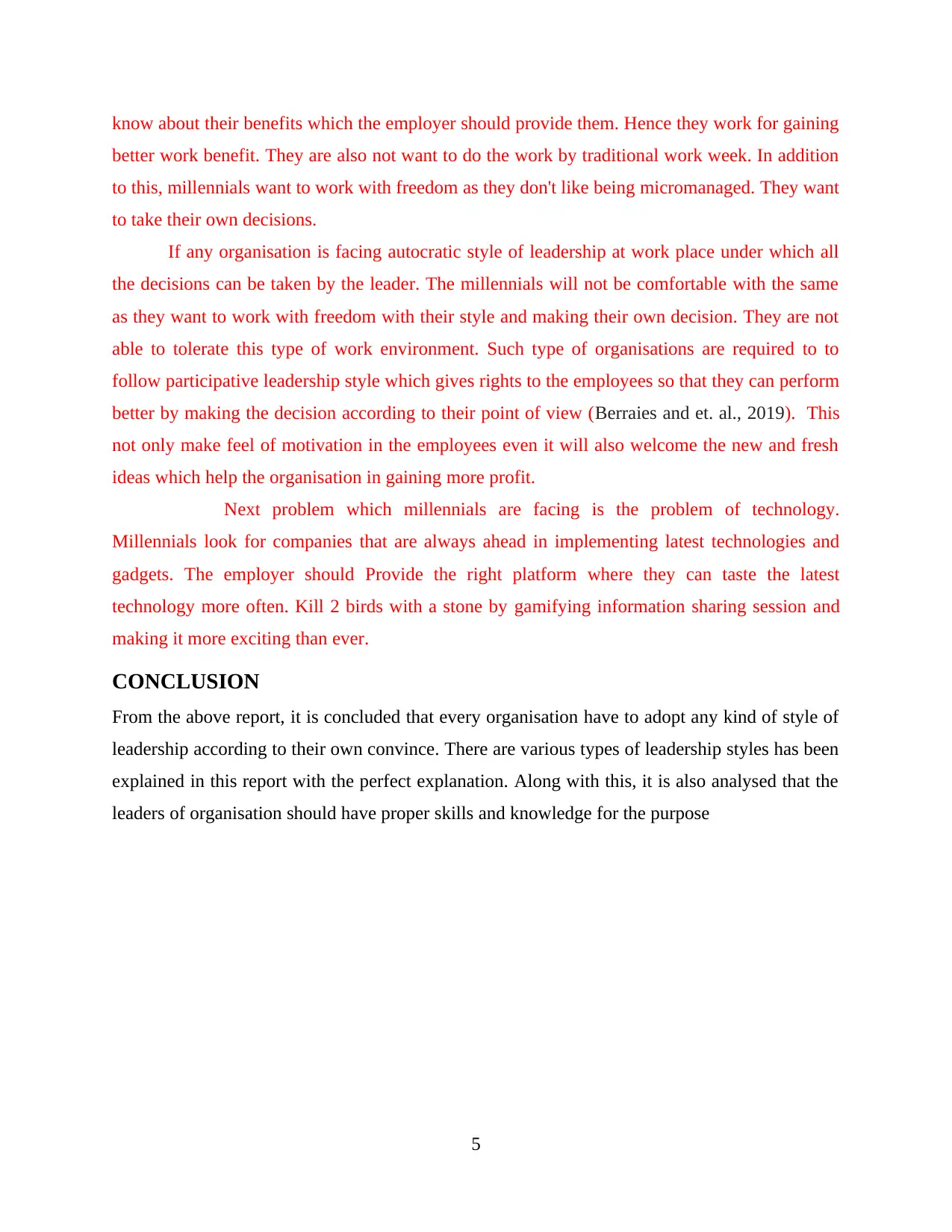
know about their benefits which the employer should provide them. Hence they work for gaining
better work benefit. They are also not want to do the work by traditional work week. In addition
to this, millennials want to work with freedom as they don't like being micromanaged. They want
to take their own decisions.
If any organisation is facing autocratic style of leadership at work place under which all
the decisions can be taken by the leader. The millennials will not be comfortable with the same
as they want to work with freedom with their style and making their own decision. They are not
able to tolerate this type of work environment. Such type of organisations are required to to
follow participative leadership style which gives rights to the employees so that they can perform
better by making the decision according to their point of view (Berraies and et. al., 2019). This
not only make feel of motivation in the employees even it will also welcome the new and fresh
ideas which help the organisation in gaining more profit.
Next problem which millennials are facing is the problem of technology.
Millennials look for companies that are always ahead in implementing latest technologies and
gadgets. The employer should Provide the right platform where they can taste the latest
technology more often. Kill 2 birds with a stone by gamifying information sharing session and
making it more exciting than ever.
CONCLUSION
From the above report, it is concluded that every organisation have to adopt any kind of style of
leadership according to their own convince. There are various types of leadership styles has been
explained in this report with the perfect explanation. Along with this, it is also analysed that the
leaders of organisation should have proper skills and knowledge for the purpose
5
better work benefit. They are also not want to do the work by traditional work week. In addition
to this, millennials want to work with freedom as they don't like being micromanaged. They want
to take their own decisions.
If any organisation is facing autocratic style of leadership at work place under which all
the decisions can be taken by the leader. The millennials will not be comfortable with the same
as they want to work with freedom with their style and making their own decision. They are not
able to tolerate this type of work environment. Such type of organisations are required to to
follow participative leadership style which gives rights to the employees so that they can perform
better by making the decision according to their point of view (Berraies and et. al., 2019). This
not only make feel of motivation in the employees even it will also welcome the new and fresh
ideas which help the organisation in gaining more profit.
Next problem which millennials are facing is the problem of technology.
Millennials look for companies that are always ahead in implementing latest technologies and
gadgets. The employer should Provide the right platform where they can taste the latest
technology more often. Kill 2 birds with a stone by gamifying information sharing session and
making it more exciting than ever.
CONCLUSION
From the above report, it is concluded that every organisation have to adopt any kind of style of
leadership according to their own convince. There are various types of leadership styles has been
explained in this report with the perfect explanation. Along with this, it is also analysed that the
leaders of organisation should have proper skills and knowledge for the purpose
5
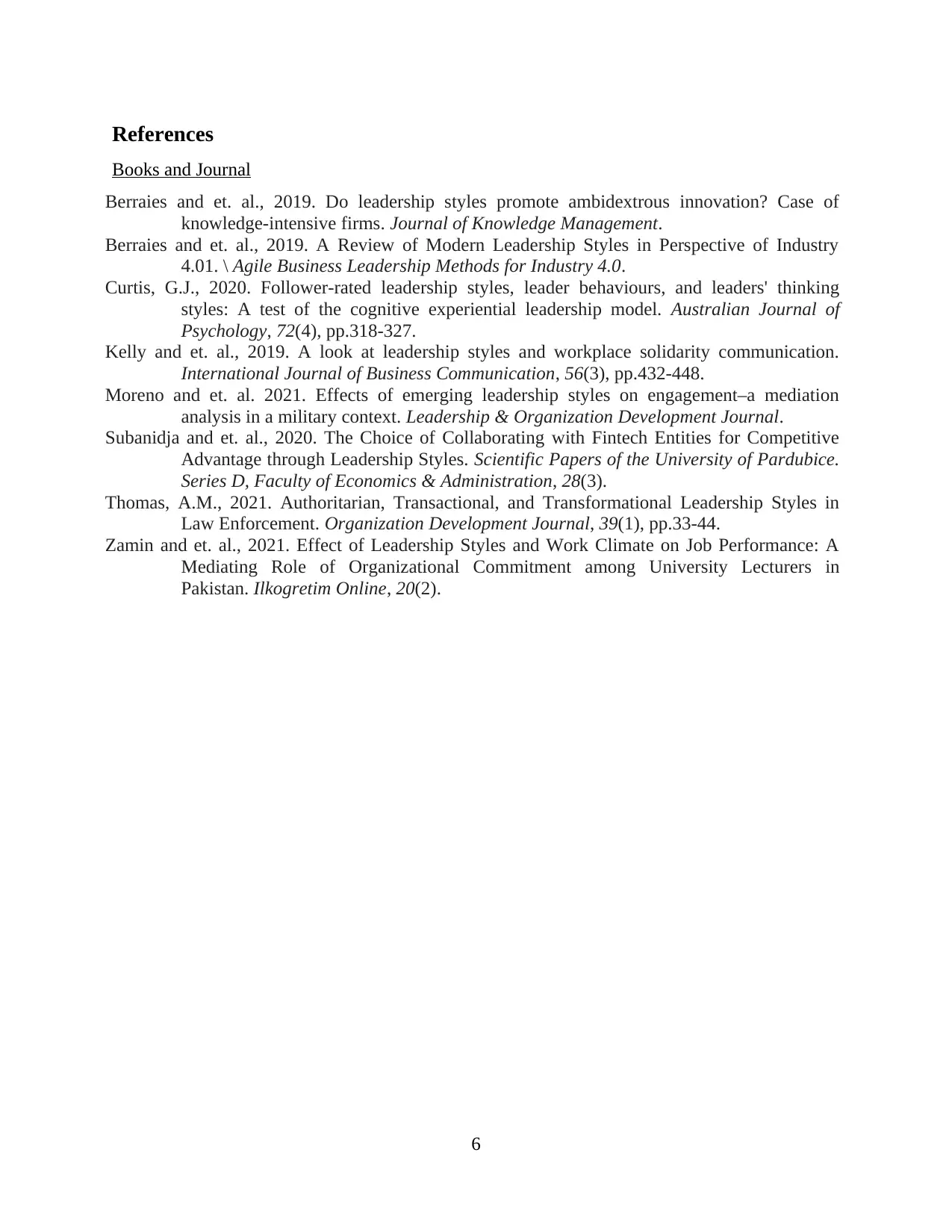
References
Books and Journal
Berraies and et. al., 2019. Do leadership styles promote ambidextrous innovation? Case of
knowledge-intensive firms. Journal of Knowledge Management.
Berraies and et. al., 2019. A Review of Modern Leadership Styles in Perspective of Industry
4.01. \ Agile Business Leadership Methods for Industry 4.0.
Curtis, G.J., 2020. Follower‐rated leadership styles, leader behaviours, and leaders' thinking
styles: A test of the cognitive experiential leadership model. Australian Journal of
Psychology, 72(4), pp.318-327.
Kelly and et. al., 2019. A look at leadership styles and workplace solidarity communication.
International Journal of Business Communication, 56(3), pp.432-448.
Moreno and et. al. 2021. Effects of emerging leadership styles on engagement–a mediation
analysis in a military context. Leadership & Organization Development Journal.
Subanidja and et. al., 2020. The Choice of Collaborating with Fintech Entities for Competitive
Advantage through Leadership Styles. Scientific Papers of the University of Pardubice.
Series D, Faculty of Economics & Administration, 28(3).
Thomas, A.M., 2021. Authoritarian, Transactional, and Transformational Leadership Styles in
Law Enforcement. Organization Development Journal, 39(1), pp.33-44.
Zamin and et. al., 2021. Effect of Leadership Styles and Work Climate on Job Performance: A
Mediating Role of Organizational Commitment among University Lecturers in
Pakistan. Ilkogretim Online, 20(2).
6
Books and Journal
Berraies and et. al., 2019. Do leadership styles promote ambidextrous innovation? Case of
knowledge-intensive firms. Journal of Knowledge Management.
Berraies and et. al., 2019. A Review of Modern Leadership Styles in Perspective of Industry
4.01. \ Agile Business Leadership Methods for Industry 4.0.
Curtis, G.J., 2020. Follower‐rated leadership styles, leader behaviours, and leaders' thinking
styles: A test of the cognitive experiential leadership model. Australian Journal of
Psychology, 72(4), pp.318-327.
Kelly and et. al., 2019. A look at leadership styles and workplace solidarity communication.
International Journal of Business Communication, 56(3), pp.432-448.
Moreno and et. al. 2021. Effects of emerging leadership styles on engagement–a mediation
analysis in a military context. Leadership & Organization Development Journal.
Subanidja and et. al., 2020. The Choice of Collaborating with Fintech Entities for Competitive
Advantage through Leadership Styles. Scientific Papers of the University of Pardubice.
Series D, Faculty of Economics & Administration, 28(3).
Thomas, A.M., 2021. Authoritarian, Transactional, and Transformational Leadership Styles in
Law Enforcement. Organization Development Journal, 39(1), pp.33-44.
Zamin and et. al., 2021. Effect of Leadership Styles and Work Climate on Job Performance: A
Mediating Role of Organizational Commitment among University Lecturers in
Pakistan. Ilkogretim Online, 20(2).
6
⊘ This is a preview!⊘
Do you want full access?
Subscribe today to unlock all pages.

Trusted by 1+ million students worldwide

7
1 out of 7
Related Documents
Your All-in-One AI-Powered Toolkit for Academic Success.
+13062052269
info@desklib.com
Available 24*7 on WhatsApp / Email
![[object Object]](/_next/static/media/star-bottom.7253800d.svg)
Unlock your academic potential
Copyright © 2020–2025 A2Z Services. All Rights Reserved. Developed and managed by ZUCOL.




